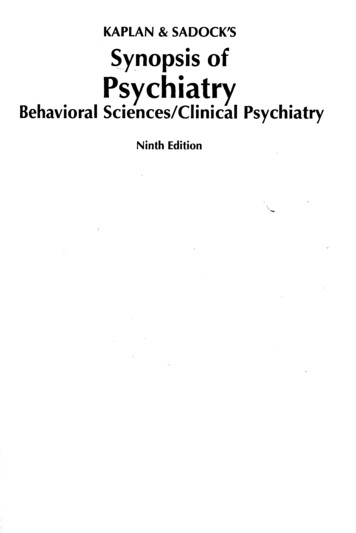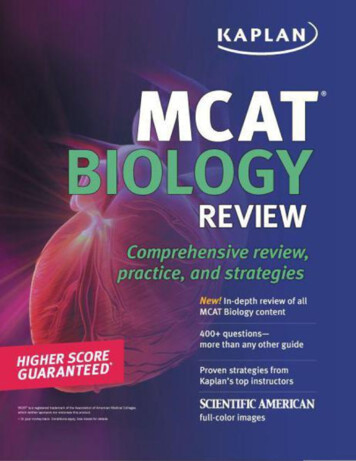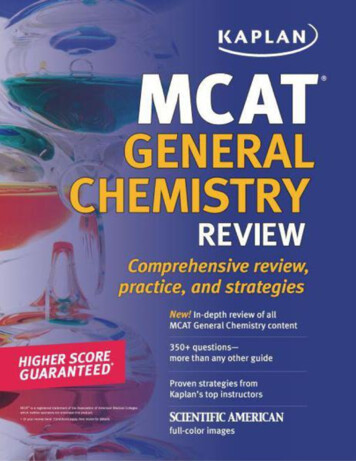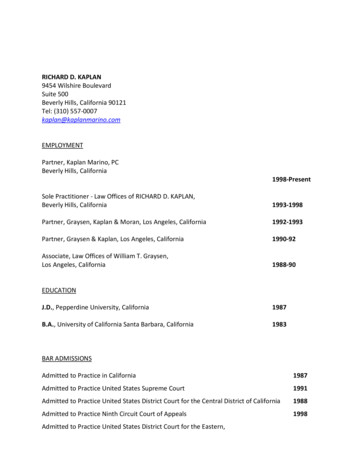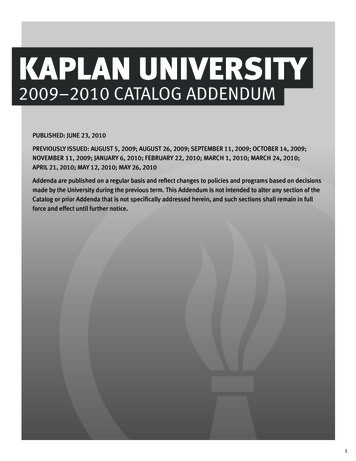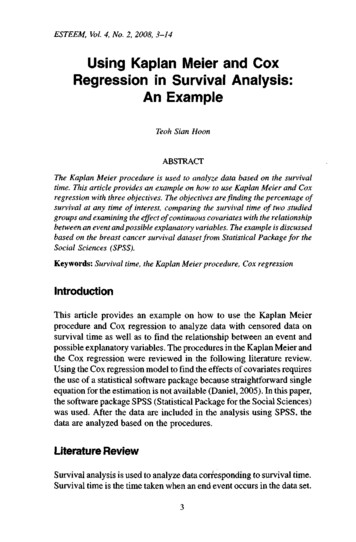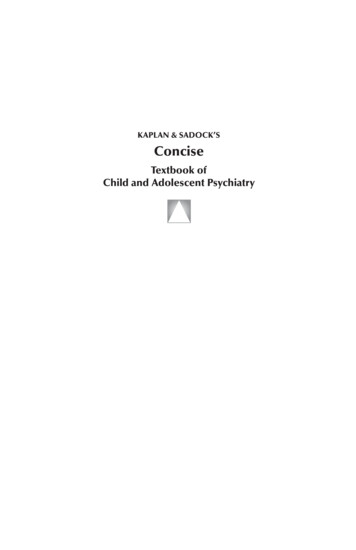
Transcription
P1: PBU/OVYP2: PBU/OVYLWBK081-FM978-0-7817-9387-2QC: PBU/OVYT1: PBUPRINTER: RR Donnelley WillardLWBK081-Sadock-v1.clsJuly 10, 2008KAPLAN & SADOCK’SConciseTextbook ofChild and Adolescent Psychiatryi10:30
P1: PBU/OVYP2: PBU/OVYLWBK081-FM978-0-7817-9387-2QC: PBU/OVYT1: PBUPRINTER: RR Donnelley WillardLWBK081-Sadock-v1.clsJuly 10, 2008CONSULTING E DITORCaroly S. Pataki, M.D.Clinical Professor of Psychiatry and Behavioral Sciences, and Division Chief, Child andAdolescent Psychiatry, Keck School of Medicine at the University of SouthernCalifornia, Los Angeles, California.CONTRIBUTING E DITORSamoon Ahmad, M.D.Clinical Associate Professor of Psychiatry and Co-director of ContinuingMedical Education, Department of Psychiatry, NYU School of Medicine,NYU Langone Medical Center, Attending Psychiatrist, Tisch Hospital,Bellevue Hospital, New York, New York.ii10:30
P1: PBU/OVYP2: PBU/OVYLWBK081-FM978-0-7817-9387-2QC: PBU/OVYT1: PBUPRINTER: RR Donnelley WillardLWBK081-Sadock-v1.clsJuly 10, 2008KAPLAN & SADOCK’SConciseTextbook ofChild and Adolescent PsychiatryBenjamin James Sadock, M.D.Menas S. Gregory Professor of Psychiatry and Vice ChairmanDepartment of Psychiatry, New York University School of Medicine, NYU LangoneMedical Center;Attending Psychiatrist, Tisch Hospital;Attending Psychiatrist, Bellevue Hospital Center;Consulting Psychiatrist, Lenox Hill Hospital,New York, New YorkVirginia Alcott Sadock, M.D.Professor of Psychiatry, Department of Psychiatry,New York University School of Medicine, NYU Langone Medical Center;Attending Psychiatrist, Tisch Hospital;Attending Psychiatrist, Bellevue Hospital Center,New York, New Yorkiii10:30
P1: PBU/OVYP2: PBU/OVYLWBK081-FM978-0-7817-9387-2QC: PBU/OVYT1: PBUPRINTER: RR Donnelley WillardLWBK081-Sadock-v1.clsJuly 10, 2008Acquisitions Editor: Charles W. MitchellManaging Editor: Sirkka E. HowesMarketing Manager: Kimberly SchonbergerProduction Editor: Bridgett DoughertyManufacturing Manager: Kathleen BrownDesign Coordinator: Steve DrudingrCompositor: Aptara 2009 by LIPPINCOTT WILLIAMS & WILKINS, a WOLTERS KLUWER BUSINESS530 Walnut StreetPhiladelphia, PA 19106 USALWW.com“Kaplan Sadock Psychiatry” with the pyramid logo is a trademark of Lippincott Williams &Wilkins.All rights reserved. This book is protected by copyright. No part of this book may be reproducedin any form or by any means, including photocopying, or utilized by any information storageand retrieval system without written permission from the copyright owner, except for briefquotations embodied in critical articles and reviews. Materials appearing in this book preparedby individuals as part of their official duties as U.S. government employees are not covered bythe above-mentioned copyright.Printed in USALibrary of Congress Cataloging-in-Publication DataSadock, Benjamin J., 1933–Kaplan & Sadock’s concise textbook of child and adolescent psychiatry / Benjamin JamesSadock, Virginia Alcott Sadock.p. ; cm.An updated and clinical presentation of material from: Kaplan & Sadock’s synopsis ofpsychiatry. 10th ed. 2007.Includes bibliographical references and index.ISBN-13: 978-0-7817-9387-2 (alk. paper)ISBN-10: 0-7817-9387-4 (alk. paper)1. Child psychiatry. 2. Adolescent psychiatry/ I. Sadock, Virginia A. II. Kaplan,Harold I., 1927– III. Sadock, Benjamin J., 1933– Kaplan & Sadock’s synopsis of psychiatry.IV. Title. V. Title: Concise textbook of child and adolescent psychiatry. VI. Title: Kaplanand Sadock’s concise textbook of child and adolescent psychiatry.[DNLM: 1. Mental Disorders—diagnosis. 2. Mental Disorders—therapy. 3. Adolescent.4. Child. WS 350 S126k 2009]RJ499.S18 2009616.89—dc222008026359Care has been taken to confirm the accuracy of the information presented and to describegenerally accepted practices. However, the authors, editors, and publisher are not responsible forerrors or omissions or for any consequences from application of the information in this book andmake no warranty, expressed or implied, with respect to the currency, completeness, or accuracyof the contents of the publication. Application of this information in a particular situationremains the professional responsibility of the practitioner.The authors, editors, and publisher have exerted every effort to ensure that drug selectionand dosage set forth in this text are in accordance with current recommendations and practice atthe time of publication. However, in view of ongoing research, changes in governmentregulations, and the constant flow of information relating to drug therapy and drug reactions, thereader is urged to check the package insert for each drug for any change in indications anddosage and for added warnings and precautions. This is particularly important when therecommended agent is a new or infrequently employed drug.Some drugs and medical devices presented in this publication have Food and DrugAdministration (FDA) clearance for limited use in restricted research settings. It is theresponsibility of the clinician to ascertain the FDA status of each drug or device planned for usein their clinical practice.To purchase additional copies of this book, call our customer service department at (800)638-3030 or fax orders to (301) 223-2320. International customers should call (301) 223-2300.Visit Lippincott Williams & Wilkins on the Internet: at LWW.com. Lippincott Williams &Wilkins customer service representatives are available from 8:30 am to 6 pm, EST.10 9 8 7 6 5 4 3 2 1iv10:30
P1: PBU/OVYP2: PBU/OVYLWBK081-FM978-0-7817-9387-2QC: PBU/OVYT1: PBUPRINTER: RR Donnelley WillardLWBK081-Sadock-v1.clsJuly 10, 2008ToEmily and Celiav10:30
P1: PBU/OVYP2: PBU/OVYLWBK081-FM978-0-7817-9387-2QC: PBU/OVYT1: PBUPRINTER: RR Donnelley WillardLWBK081-Sadock-v1.clsJuly 10, 2008vi10:30
P1: PBU/OVYP2: PBU/OVYLWBK081-FM978-0-7817-9387-2QC: PBU/OVYT1: PBUPRINTER: RR Donnelley WillardLWBK081-Sadock-v1.clsJuly 10, 2008PrefaceThis book, Concise Textbook of Child and Adolescent Psychiatry, covers the diagnosis and treatment of mental disorders inchildren and adolescents. The reader will find detailed information about the diagnosis and treatment of every childhood andadolescent mental disorder listed in the latest fourth revised edition of the American Psychiatric Association’s Diagnostic andStatistical Manual of Mental Disorders (DSM-IV-TR). Thisbook evolved from our experience editing a larger volume,Kaplan and Sadock’s Synopsis of Psychiatry, tenth edition,which covers the behavioral sciences and all clinical psychiatricdisorders in children and adults. The elimination of the sectionson the behavioral sciences and adult psychiatry accounts for thisbook’s smaller and more manageable size. It is designed to meetthe needs of the reader who requires a compact but thoroughcoverage of the field of child and adolescent psychiatry.TEACHING SYSTEMThis textbook forms one part of a comprehensive system wehave developed to facilitate the teaching of psychiatry and thebehavioral sciences. At the head of the system is the Comprehensive Textbook of Psychiatry, which is global in depth andscope. It is designed for and used by psychiatrists, behavioralscientists, and all workers in the mental health field. Synopsisof Psychiatry is a relatively compact, highly modified, original,and current text useful for medical students, psychiatric residents, practicing psychiatrists, and mental health professionals.Another part of the system is Study Guide and Self-ExaminationReview of Psychiatry, which consists of multiple-choice questions and answers. It is designed for students of psychiatry whoare preparing for a variety of examinations. Other parts of the system are the pocket handbooks: Pocket Handbook of Clinical Psychiatry, Pocket Handbook of Psychiatric Drug Treatment, andPocket Handbook of Emergency Psychiatric Medicine. Thosebooks cover the diagnosis and the treatment of psychiatric disorders, psychopharmacology, and psychiatric emergencies, respectively, and are compactly designed and concisely written tobe carried in the pocket by clinical clerks and practicing physicians, whatever their specialty, to provide a quick reference. Another book, Concise Textbook of Clinical Psychiatry covers allclinical disorders in children and adults to provide a compactoverview of all known mental disorders. Finally, the Comprehensive Glossary of Psychiatry and Psychology provides simplywritten definitions of all terms used in psychiatry including acomplete glossary of signs and symptoms. Taken together, thoseseven books create a multipronged approach to the teaching,study, and learning of psychiatry. This text is a new addition toour teaching system.NEW AND REVISED AREASEvery section on clinical psychiatry has been updated to includethe latest information about diagnosing and treating mental illness in children and adolescents. New advances since the publication of Synopsis of Psychiatry in 2007 have been added, particularly in the ever-changing area of child psychopharmacology.The reader will find completely updated material on medication such as dosages, methods of use, warnings and side-effects,including information about all drugs approved since the lastedition was published. Data about posttraumatic stress disordersin children includes the latest information about the psychological effects on children exposed to terrorist activities and natural disasters. The section on Anxiety Disorders in Children andAdolescents was completely reorganized.FORMATCase HistoriesCase histories are an integral part of this book and are includedto make the clinical disorders more interesting and vital for thestudent. All cases in this edition are new, derived from varioussources: ICD-10 Casebook, DSM-IV-TR Casebook, DSM-IV-TRCase Studies, from contributors to the Comprehensive Textbookof Psychiatry, and from the authors’ clinical experience at NewYork’s Bellevue Hospital Center. We especially wish to thank theAmerican Psychiatric Press and the World Health Organizationfor permission to use many of their cases. Cases appear in tintedtype to help the reader find them easily.vii10:30
P1: PBU/OVYP2: PBU/OVYLWBK081-FM978-0-7817-9387-2viiiQC: PBU/OVYT1: PBULWBK081-Sadock-v1.clsPRINTER: RR Donnelley WillardJuly 10, 2008PrefaceReferencesTo conserve space, references were not included at the endof each section. The interested reader can find a completebibliography for each section by referring to either Synopsis ofPsychiatry or the Comprehensive Textbook of Psychiatry. Thosetexts will also provide an in-depth, thorough, and detailed discussion of all the topics in this book. We also are mindful ofthe fact that modern-day readers consult internet sources, suchas PsychInfo and Medline, to stay abreast of the most currentliterature and encourage that trend.B.J.S.V.A.S.10:30
P1: PBU/OVYP2: PBU/OVYLWBK081-FM978-0-7817-9387-2QC: PBU/OVYT1: PBULWBK081-Sadock-v1.clsPRINTER: RR Donnelley WillardJuly 10, 2008AcknowledgmentsWe deeply appreciate the work of our distinguished collaborator,Caroly Pataki, M.D., who was responsible for organizing, updating and revising the section on childhood and adolescent disorders in many of our books including the current ninth edition ofthe Comprehensive Textbook of Psychiatry and the tenth editionof Synopsis of Psychiatry for which she is consulting and contributing editor. She is Professor of Psychiatry and Division Chiefof Child and Adolescent Psychiatry at Keck School of Medicineat the University of Southern California in Los Angeles,California, and an extraordinary talented educator and clinician.We thank her for her tremendous help in this area.Samoon Ahmad, M.D. deserves special thanks for his roleas Consulting Editor in the field of biological psychiatry andpharmacology.Nitza Jones played a key and invaluable role as Project Editor,as she has for many of our other books. Her vast knowledgeof every aspect of book publishing was indispensable, and shecontributed heavily to editing the text. We also want to thankSara Brown who was extraordinarily helpful. They worked withenthusiasm, alacrity, and intelligence. We thank Dorice Viera,Associate Curator of the Frederick L. Ehrman Medical Library at the New York University School of Medicine, for herassistance.We also wish to acknowledge the contributions of JamesSadock, M.D., and Victoria Gregg, M.D., for their help in theirareas of expertise: emergency adult and emergency pediatricmedicine, respectively. We also thank Alan and Marilyn Zublattfor their generous support and their friendship.We want to take this opportunity to acknowledge those whohave translated this and other Kaplan & Sadock books into foreign languages, including Chinese, Croatian, French, German,Greek, Indonesian, Italian, Japanese, Polish, Portuguese, Romanian, Russian, Spanish, and Turkish, in addition to a specialAsian and international student edition.Additionally, we wish to acknowledge our great and obviousdebt to the more than 2,000 psychiatrists and behavioral scientistswho contributed to the various editions of the ComprehensiveTextbook of Psychiatry, especially to those in the field of child andadolescent mental health who allowed us to synopsize their workfor this book. At the same time, we must accept responsibilityfor the modifications and changes in the new work.The staff at Lippincott Williams & Wilkins was most efficient.We wish to thank Sirkka Howes at LWW. Chris Miller at Aptaraalso deserves our thanks. Joyce Murphy, Associate Director ofDevelopment, and Charley Mitchell, Publisher, have been loyalfriends over the years and their encouragement and enthusiasmhave been most welcome.B.J.S.V.A.S.ix10:30
P1: PBU/OVYP2: PBU/OVYLWBK081-FM978-0-7817-9387-2QC: PBU/OVYT1: PBUPRINTER: RR Donnelley WillardLWBK081-Sadock-v1.clsJuly 10, 2008x10:30
P1: PBU/OVYP2: PBU/OVYLWBK081-FM978-0-7817-9387-2QC: PBU/OVYT1: PBUPRINTER: RR Donnelley WillardLWBK081-Sadock-v1.clsJuly 10, 2008ContentsPreface viiAcknowledgments ix1Assessment, Examination, andPsychologic TestingMental Retardation133Learning Disorders334Motor Skills Disorder:Developmental CoordinationDisorder44Communication Disorders486Pervasive DevelopmentalDisordersAttention-Deficit Disorders798Disruptive Behavior Disorders929Feeding and Eating Disorders ofInfancy or Early ChildhoodTic Disorders11712Reactive Attachment Disorder ofInfancy or Early Childhood12313Stereotypic Movement Disorder andDisorders of Infancy, Childhood, orAdolescence Not OtherwiseSpecified12714Mood Disorders and Suicide13214.1 Depressive Disorders and Suicide14.2 Early-Onset Bipolar Disorders132143Anxiety Disorders14715.1 Obsessive-Compulsive Disorder15.2 Posttraumatic Stress Disorder15.3 Separation Anxiety Disorder,1471511565710Elimination Disorders1251110110815.4Generalized Anxiety Disorder,and Social PhobiaSelective Mutism15416216Early-Onset Schizophrenia16617Adolescent Substance Abuse17118Additional Conditions ThatMay Be a Focus of ClinicalAttention177xi10:30
P1: PBU/OVYP2: PBU/OVYLWBK081-FM978-0-7817-9387-2xii19QC: PBU/OVYT1: PBUPRINTER: RR Donnelley WillardLWBK081-Sadock-v1.clsJuly 10, 2008ContentsPsychiatric Treatment18419.1 Individual Psychotherapy19.2 Group Psychotherapy19.3 Residential, Day, and Hospital184191TreatmentBiological TherapiesPsychiatric Treatment ofAdolescents19319719.419.520520Special Areas of Interest21020.120.220.320.4Forensic IssuesAdoption and Foster CareChild Maltreatment and AbuseImpact of Terrorism on Children210214218225Index22910:30
P1: PBU/OVYP2: PBU/OVYLWBK081-FM978-0-7817-9387-2QC: PBU/OVYT1: PBUPRINTER: RR Donnelley WillardLWBK081-Sadock-v1.clsJuly 10, 2008KAPLAN & SADOCK TEXTBOOKSPublished by Lippincott Williams & WilkinsComprehensive Group Psychotherapy1st Edition, 19712nd Edition, 19833rd Edition, 1993Comprehensive Textbook of Psychiatry1st Edition, 1967 (with A.M. Freedman)2nd Edition, 1975 (with A.M. Freedman)3rd Edition, 1980 (with A.M. Freedman)4th Edition, 19855th Edition, 19896th Edition, 19957th Edition, 1998 (with V.A. Sadock)8th Edition, 2005 (with V.A. Sadock)The Sexual Experience1976 (with A.M. Freedman)Concise Textbook of Clinical Psychiatry1st Edition, 1996 (with V.A. Sadock)2nd Edition, 2004 (with V.A. Sadock)3rd Edition, 2008 (with V.A. Sadock)Synopsis of Psychiatry1st Edition, 1972 (with A.M. Freedman)2nd Edition, 1976 (with A.M. Freedman)3rd Edition, 19814th Edition, 19855th Edition, 19886th Edition, 19917th Edition, 1994 (with J. Grebb)8th Edition, 19989th Edition, 2003 (with V.A. Sadock)10th Edition, 2007 (with V.A. Sadock)Pocket Handbook of Clinical Psychiatry1st Edition 19902nd Edition, 19963rd Edition, 2001 (with V.A. Sadock)4th Edition, 2005 (with V.A. Sadock)Comprehensive Glossary of Psychiatry and Psychology1991Pocket Handbook of Psychiatric Drug Treatment1st Edition, 19932nd Edition, 19963rd Edition, 2001 (with V.A. Sadock)4th Edition, 2006 (with V.A. Sadock and N. Sussman)Study Guide and Self-Examination Reviewof Psychiatry1st Edition, 19832nd Edition, 19853rd Edition, 19894th Edition, 19915th Edition, 19946th Edition, 1999 (with V.A. Sadock)7th Edition, 2003 (with V.A. Sadock and R.M. Jones)8th Edition, 2007 (with V.A. Sadock and Z. Levin)Pocket Handbook of Emergency Psychiatric Medicine1993Pocket Handbook of Primary Care Psychiatry1996Various editions of the above books have been translated and published in Bulgarian, Croatian, French, German,Greek, Indonesian, Italian, Japanese, Polish, Portuguese, Russian, Spanish, and Turkish. In addition, an International Asian editionhas been published in English.BY OTHER PUBLISHERSModern Group Books I–VI1972E.P. DuttonI. Origins of Group AnalysisII. Evolution of Group TherapyIII. Groups and DrugsIV. Sensitivity through Encounter and MotivationV. New Models for Group TherapyVI. Group Treatment of Mental IllnessStudies in Human Behavior, 1–51972 (with A.M. Freedman)Athenaeum1. Diagnosing Mental Illness: Evaluation in Psychiatry andPsychology2. Interpreting Personality: A Survey of TwentiethCentury Views3. Human Behavior: Biological, Psychological, andSociological4. Treating Mental Illness: Aspects of Modern Therapy5. The Child: His Psychological and Cultural DevelopmentVolume 1: Normal Development and Psychological AssessmentVolume 2: The Major Psychological Disorders and theirTreatmentxiiiThe Human Animal1974 (with A.M. Freedman)K.F.S. PublicationsVolume 1: Man and His MindVolume 2: The Disordered Personality10:30
P1: PBU/OVYP2: PBU/OVYLWBK081-FM978-0-7817-9387-2QC: PBU/OVYT1: PBUPRINTER: RR Donnelley WillardLWBK081-Sadock-v1.clsJuly 10, 2008xiv10:30
P1: PBU/OVYP2: PBU/OVYLWBK081-FM978-0-7817-9387-2QC: PBU/OVYT1: PBUPRINTER: RR Donnelley WillardLWBK081-Sadock-v1.clsJuly 10, 2008KAPLAN & SADOCK’SConciseTextbook ofChild and Adolescent Psychiatryxv10:30
P1: PBU/OVYP2: PBU/OVYLWBK081-FM978-0-7817-9387-2QC: PBU/OVYT1: PBUPRINTER: RR Donnelley WillardLWBK081-Sadock-v1.clsJuly 10, 2008xvi10:30
P1: OSO/OVYP2: OSO/OVYLWBK081-01978-0-7817-9387-2QC: OSO/OVYT1: OSOPRINTER: RR Donnelley WillardLWBK081-Sadock-v1.clsJuly 3, 20081Assessment, Examination, andPsychologic TestingPsychiatric assessment of a child or adolescent includes identifying the reasons for referral; assessing the nature and extentof the child’s psychologic and behavioral difficulties; and determining family, school, social, and developmental factors thatmay be influencing the child’s emotional well-being.A comprehensive evaluation of a child is composed of interviews with the parents, the child, and other family members; gathering information regarding the child’s current schoolfunctioning; and, often, a standardized assessment of the child’sintellectual level and academic achievement. In some cases, standardized measures of developmental level and neuropsychologicassessments are useful.Psychiatric evaluations of children are rarely initiated by thechild, so clinicians must obtain information from the family andthe school to understand the reasons for the evaluation. In somecases, the court or a child protective service agency may initiatea psychiatric evaluation. Children can be excellent informantsabout symptoms related to mood and inner experiences, suchas psychotic phenomena, sadness, fears, and anxiety, but theyoften have difficulty with the chronology of symptoms and aresometimes reticent about reporting behaviors that have gottenthem into trouble. Very young children often cannot articulatetheir experiences verbally and do better showing their feelingsand preoccupations in a play situation.The first step in the comprehensive evaluation of a child oradolescent is to obtain a full description of the current concernsand a history of the child’s previous psychiatric and medicalproblems. This part of the evaluation is often done with the parents for school-age children, whereas adolescents may be seenalone first, to get their perception of the situation. Direct interview and observation of the child is usually next, followed bypsychologic testing, when indicated.Clinical interviews offer the most flexibility in understanding the evolution of problems and in establishing the role ofenvironmental factors and life events, but they may not systematically cover all psychiatric diagnostic categories. To increase the breadth of information generated, the clinician mayuse semistructured interviews, such as the Kiddie Schedule forAffective Disorders and Schizophrenia for School-Age Children(K-SADS); structured interviews, such as the National Institutefor Mental Health Diagnostic Interview Schedule for ChildrenVersion IV (NIMH DISC-IV); and rating scales, such as the ChildBehavior Checklist and Connors Parent or Teacher Rating Scalefor ADHD.It is not uncommon for interviews from different sources,such as parents, teachers, and school counselors, to reflect different or even contradictory information about a given child.When faced with conflicting information, the clinician must determine whether apparent contradictions actually reflect an accurate picture of the child in different settings. After a completehistory is obtained from the parents, the child is examined, thechild’s current functioning at home and at school is assessed,and psychologic testing is completed, the clinician can use allthe available information to make a best-estimate diagnosis andcan then make recommendations.After clinical information is obtained about a child or adolescent, it is the clinician’s task to determine whether criteriaare met for one or more psychiatric disorders according to thetext revision of the 4th edition of the Diagnostic and StatisticManual of Mental Disorders (DSM-IV-TR). This most currentversion is a categoric classification reflecting the consensus onconstellations of symptoms believed to comprise discrete andvalid psychiatric disorders. A psychiatric disorder is defined bythe DSM-IV-TR as a clinically significant set of symptoms thatis associated with impairment in one or more areas of functioning. Although clinical situations requiring intervention donot always fall within the context of a given psychiatric disorder, it is important to identify psychiatric disorders when theyarise to facilitate meaningful investigation of childhood psychopathology.CLINICAL INTERVIEWSTo conduct a useful interview with a child of any age, cliniciansmust be familiar with normal development to place the child’sresponses in the proper perspective. For example, a young child’sdiscomfort on separation from a parent and a school-age child’slack of clarity about the purpose of the interview are both normal and should not be misconstrued as psychiatric symptoms.Furthermore, behavior that is normal in a child at one age, such115:9
P1: OSO/OVYP2: OSO/OVYLWBK081-01978-0-7817-9387-22QC: OSO/OVYT1: OSOPRINTER: RR Donnelley WillardLWBK081-Sadock-v1.clsJuly 3, 2008Chapter 1: Assessment, Examination, and Psychologic Testingas temper tantrums in a 2-year-old, takes on a different meaning,for example, in a 17-year-old.The interviewer’s first task is to engage the child and developa rapport so that the child is comfortable. The interviewer shouldinquire about the child’s concept of the purpose of the interviewand should ask what the parents have told the child. If the childseems confused about the reason for the interview, the examinermay opt to summarize the parents’ concerns in a developmentallyappropriate and supportive manner. During the interview with thechild, the clinician seeks to learn about the child’s relationshipswith family members and peers, academic achievement and peerrelationships in school, and the child’s pleasurable activities. Anestimate of the child’s cognitive functioning is a part of the mentalstatus examination.The extent of confidentiality in child assessment is correlatedwith the age of the child. In most cases, almost all specific information can appropriately be shared with the parents of a veryyoung child, whereas privacy and permission of an older childor adolescent are mandated before sharing information with parents. School-age and older children are informed that if the clinician becomes concerned that the child is dangerous to himselfor herself or to others, this information must be shared with parents and, sometimes, additional adults. As part of a psychiatricassessment of a child of any age, the clinician must determinewhether that child is safe in his or her environment and mustdevelop an index of suspicion about whether the child is a victim of abuse or neglect. Whenever there is a suspicion of childmaltreatment, the local child protective service agency must benotified.Toward the end of the interview, the child may be asked inan open-ended manner whether he or she would like to bring upanything else. Each child should be complimented for his or hercooperation and thanked for participating in the interview, andthe interview should end on a positive note.Infants and Young ChildrenAssessments of infants usually begin with the parents presentbecause very young children may be frightened by the interviewsituation; the interview with the parents present also allows theclinician to assess the parent–infant interaction. Infants may bereferred for a variety of reasons, including high levels of irritability, difficulty being consoled, eating disturbances, poor weightgain, sleep disturbances, withdrawn behavior, lack of engagement in play, and developmental delay. The clinician assessesareas of functioning that include motor development, activitylevel, verbal communication, ability to engage in play, problemsolving skills, adaptation to daily routines, relationships, andsocial responsiveness.The child’s developmental level of functioning is determinedby combining observations made during the interview with standardized developmental measures. Observations of play reveal achild’s developmental level and reflect the child’s emotional stateand preoccupations. The examiner can interact with an infant18 months or younger in a playful manner by using games suchas peek-a-boo. Children 18 months to 3 years old can be observedin a playroom. Children 2 years or older may exhibit symbolicplay with toys, revealing more in this mode than through conversation. The use of puppets and dolls with children younger than6 years is often an effective way to elicit information, especiallyif questions are directed to the dolls, rather than to the child.School-Age ChildrenSome school-age children are at ease when conversing with anadult; others are hampered by fear, anxiety, poor verbal skills, oroppositional behavior. School-age children can usually tolerate a45-minute session. The room should be sufficiently spacious forthe child to move around, but not so large as to reduce intimatecontact between the examiner and the child. Part of the interviewcan be reserved for unstructured play, and various toys can bemade available to capture the child’s interest and to elicit themesand feelings. Children in lower grades may be more interestedin the toys in the room, whereas by the sixth grade, children maybe more comfortable with the interview process and less likelyto exhibit spontaneous play.The initial part of the interview explores the child’s understanding of the reasons for the meeting. The clinician shouldconfirm that the interview was not set up because the child is“in trouble” or as a punishment for “bad” behavior. Techniquesthat can facilitate disclosure of feelings include asking the childto draw peers, family members, a house, or anything else thatcomes to mind. The child can then be questioned about the drawings. Children may be asked to reveal three wishes, to describethe best and worst events of their lives, and to name a favoriteperson to be stranded with on a desert island. Games, such asDonald W. Winnicott’s “squiggle” in which the examiner drawsa curved line and then the child and the examiner take turnscontinuing the drawing, may facilitate conversation.Questions that are partially open-ended with some multiplechoices may elicit the most complete answers from school-agechildren. Simple, closed (yes or no) questions may not elicit sufficient information, and completely open-ended questions canoverwhelm a school-age child who cannot construct a chronologic narrative. These techniques often result in a shoulder shrugfrom the child. The use of indirect commentary—such as, “I onceknew a child who felt very sad when he moved away from allhis friends”—is helpful, although the clinician must be carefulnot to lead the child into confirming what the child thinks theclinician wants to hear. School-age children respond well to clinicians who help them compare moods or feelings by asking themto rate feelings on a scale of 1 to 10.AdolescentsAdolescents usually have distinct ideas about why the evaluation was initiated and can usually give a chronologic account ofthe recent events leading to the evaluation, although some may15:9
P1: OSO/OVYP2: OSO/OVYLWBK081-01978-0-7817-9387-2QC: OSO/OVYT1: OSOPRINTER: RR Donnelley WillardLWBK081-Sadock-v1.clsJuly 3, 2008Chapter
Kaplan and Sadock’s Synopsis of Psychiatry, tenth edition, . Another part of the system is Study Guide and Self-Examination Review of Psychiatry, which consists of multiple-choice ques- . study, and learning of psychi

